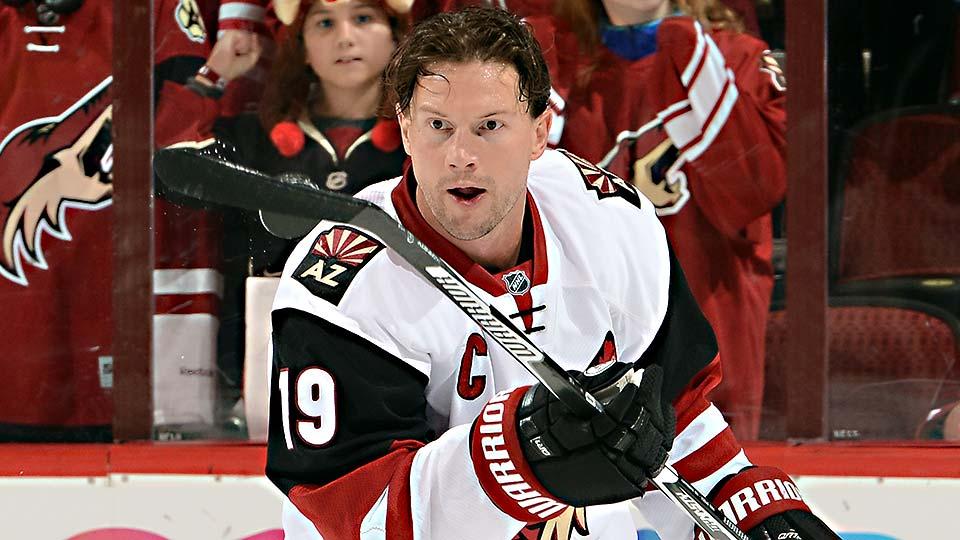
BY JEREMY FUCHS
The elevator approaches the fifth floor of Madison Square Garden carrying the past, present and future of the Arizona Coyotes: Shane Doan, Anthony Duclair and Max Domi. The revered teacher and his two brilliant young pupils.
At age 39, Doan is still captain, still the face of the franchise. The end of his career is coming before long, though. But for now the youth-laden Coyotes are in the playoff hunt—and they’re looking to Doan to get them there.
It’s all just an honor to lead, he says, all just his honor. There’s no to-do list, no giant book of reminders, no executive planning meetings, just feel, intuition and experience. That’s how he’s led since the C was applied to his sweater in 2003. He focuses on being himself, puts the team first.
“Just keep getting better, every day,” Domi, 20, says of what he’s learned from Doan. Work hard. Domi watches and observes, sees what the captain does to get better, then replicates it.
That’s what Doan did as a kid in the league, starting when he was 19 and the franchise called Winnipeg its home. He watched guys like Teemu Selanne and Keith Tkachuk, guys like Eddie Olczyk and Darrin Shannon, watched their love for the game. One lesson he learned: Love the game and you’ll have more success. Do things the right way.
Now Doan applies his lessons when 20 guys look to him for guidance and answers. He stays steadfast when there are rumors swirling—the franchise is in trouble; someone is going be traded—as they always seem to be in Arizona. Most of the time, he ignored them, didn’t give them credence, just continued on his path and focused on the main business on the ice.
“For the most part, all the news [and] we’re still here and going along,” Doan says.
The teacher also remains a student. He acknowledges the line of captains that came before him, knows that he can’t let down the guys before him, can’t let down Teppo Numminen, Keith Tkachuk, Dale Hawerchuk and the others. He wears the C proudly on his chest because of all who wore it before him, not just in Arizona, but all over the league. It’s an honor, his youth coaches would tell him. It’s a responsibility, but it’s part of a glorious hockey tradition.
“You need to behave and act accordingly and that’s the tradition of our sport,” Doan says. “And [that’s] what I love about our sport. It’s held at such a high standard. If you’re not willing to do this, you’re not going to be captain. You don’t want to be the person that drops the ball and suddenly the prestige of the captain is tarnished.”
Doan is the elder statesmen now, the oldest on a team that has nine players who are 25 or younger. Not that he can’t keep up—he’s seventh on the Coyotes in scoring—but the team that has always been his is slowly changing its guard. It’s about Domi and Duclair, 20, of course, but there are promising youngsters everywhere. Mikkel Boedker, 25, is off to a good start. There’s Oliver Ekman-Larsson, 24, one of the best defenders in the game. There’s Tobias Rieder, 22, and Jordan Martinook, 23, and in juniors Dylan Strome, 18, is proving that he’s more than just Connor McDavid’s running mate. A little further up the age ladder, Martin Hanzal, 28, is having a career year.
There’s a solid core being built for a team that’s currently seventh in the Western Conference, and all Doan wants to do is contribute and help. He’s still fiercely competitive, his coach, Dave Tippett, says. He still wants to win. The desire is there, even if his days of 30-goal seasons are long gone. He’s still the first one to play video games, still thinks he’s a little kid.
It’s late on a Friday night and Doan apologizes to a reporter, saying he just couldn’t get away. Couldn’t break away from those who needed it. Couldn’t leave the IceDen in Scottsdale, not when there’s pizza and salad and lemonade and folks from the HopeKids charity who need a lift, who just want a picture and an autograph. He’s been involved with the organization forever, says Lisa Sweeney, the charity’s program manager. Always there for the 911 situations, when kids with traumatic, life-threatening illnesses need to think about something other than needles and tests. He’s there when families and siblings need to be reminded that there is a world outside of hospitals and waiting rooms.